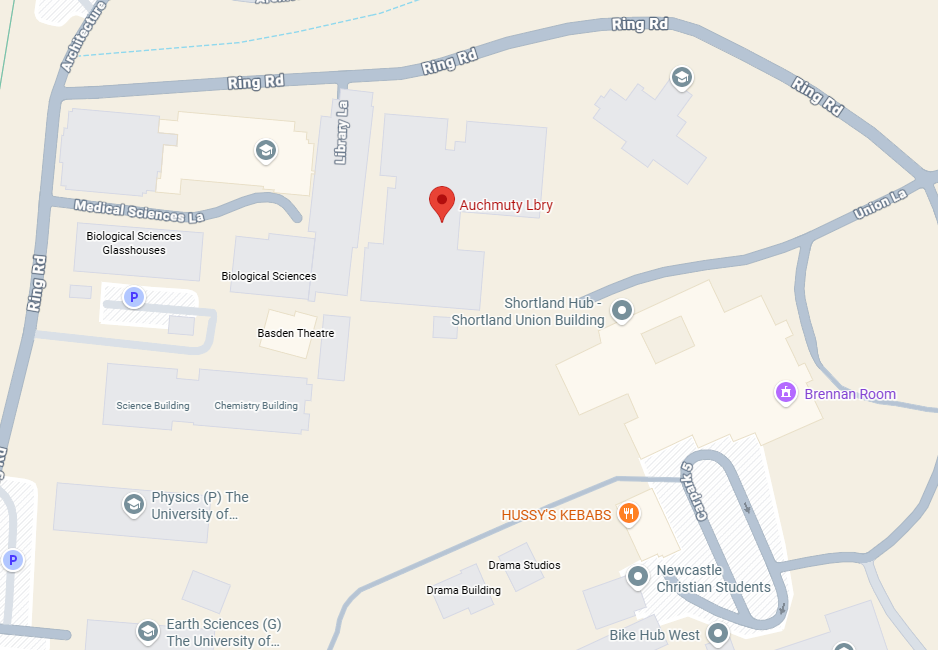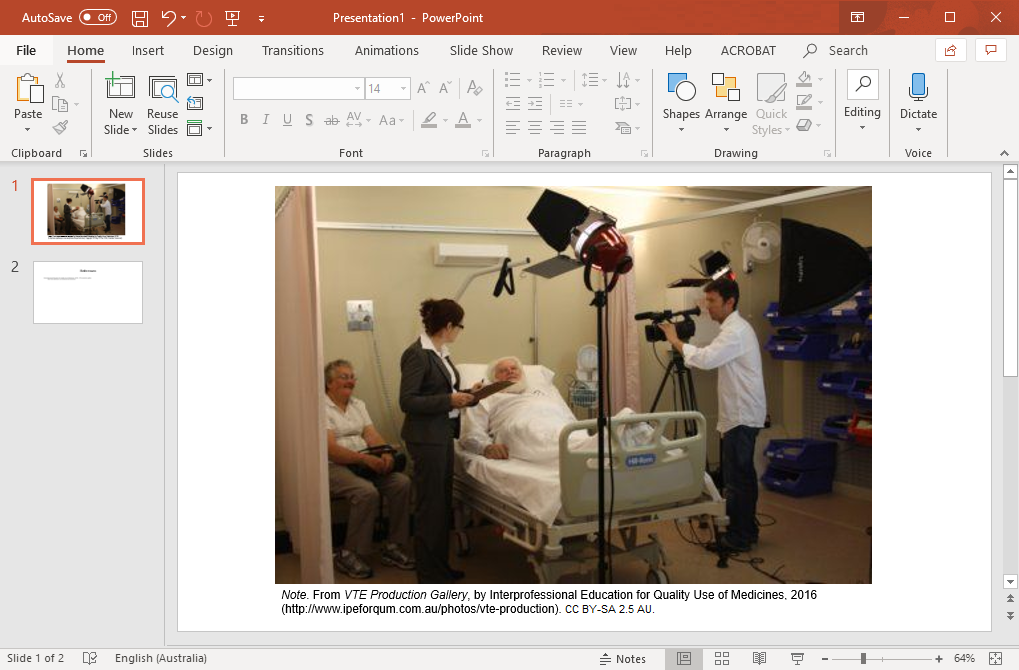04 June 2025 - Please note that information on this page has been updated for Semester 2
Additional/updated direction has been provided for some image sources:
- copyright statements and Creative Commons licences (What is Creative Commons?), and
- images from the web, including
- images that don't require attribution.
Referencing image and art sources
|
APA uses the terminology 'figures' when discussing image sources. 'Figures' includes the following image types:
Note that tables are a separate designation with differing rules. See the Tables tabs for more information. Physical artworks can referenced differently, depending on whether an image is being reproduced. See the Physical art works tab for more information. |
The following are brief guidelines describing how to format figures when reproducing them in your assignments. These guidelines have been adapted from the Publication Manual of the American Psychological Association. Please refer to the indicated page numbers within the Publication Manual for further clarification and explanation.
Guidelines for figures: |
|
Figures taken from journal sources
|
If you are including a figure you found in another source within an assignment:
|
|
Part 1 - Cite the article as you would normally and mention the figure in your text:
|
|
Part 2 - Provide description and captioning of your figure: [Above the figure] Figure X [Bolded, where X is your numbering] Title of Figure [Below the figure] Note. From "Title of Article," by A. A. Author and B. B. Author, Year, Title of Journal, volume(issue), p. xx (https://doi.org/DOI). Copyright Year by Copyright Holder Name. or Note. From "Title of Article," by A. A. Author and B. B. Author, Year, Title of Journal, volume(issue), p. xx (https://doi.org/DOI). Creative Commons Licence. Where the article is licensed under Creative Commons, you can add this in place of a copyright statement, e.g., 'CC BY 4.0.' What is Creative Commons?
|
|
Part 3 - Reference the article as you would normally:
|
Not reproducing the figure?Follow the standard in-text citation and reference list entry to reference the article. |
|
Reproduction note: The figure above, reprinted from Nurse Education Today, has been reproduced with permission. This notice is separate from the figure so as not to confuse the referencing in the figure caption. |
Figures taken from authored books
|
If you are including a figure you found in another source within an assignment:
|
|
The figure below is taken from an ebook where all of the content was written by the same author. In these cases the full book is referenced. As this ebook does not use page numbers, the chapter information has been included instead to assist with locating the original. Note that the ebook has been shared under a Creative Commons Licence so this information has been included in place of a copyright statement. What is Creative Commons?
|
|
Part 1 - Cite the book as you would normally and mention the figure in your text:
|
|
Part 2 - Provide description and captioning of your figure: [Above the figure] Figure X [Bolded, where X is your numbering] Title of Figure [Below the figure] Note. From Title of Book (edition, p. xx), by A. A. Author and B. B. Author, Year, Publisher (DOI or link). Copyright Year by Copyright Holder Name. or Note. From Title of Book (edition, p. xx), by A. A. Author and B. B. Author, Year, Publisher (DOI or link). Creative Commons Licence. [In this example we're including the Creative Commons Licence the image was shared under instead of a copyright statement]
|
|
Part 3 - Reference the book as you would normally:
|
Not reproducing the figure?Follow the standard in-text citation and reference list entry to reference the book. |
|
The figure above, reprinted from Clinical Procedures for Safer Patient Care, has been reproduced under a Creative Commons Attribution-NonCommercial-ShareAlike 4.0 International License. This notice is separate from the figure so as not to confuse the referencing in the figure caption. |
Figures taken from edited books
|
If you are including a figure you found in another source within an assignment:
|
|
The figure below is taken from a chapter from an edited ebook where each chapter has different authors. In these cases the individual chapters are referenced. Note that the ebook has been shared under a Creative Commons Licence so this information has been included in place of a copyright statement. What is Creative Commons?
|
|
Part 1 - Cite the book chapter as you would normally and mention the figure in your text:
|
|
Part 2 - Provide description and captioning of your figure: [Above the figure] Figure X [Bolded, where X is your numbering] Title of Figure [Below the figure] Note. From "Title of Chapter," by A. A. Author and B. B. Author, in C. C. Editor and D. D. Editor (Eds.), Year, Title of Book (edition, p. xx). Publisher (DOI or link). Copyright Year by Copyright Holder Name. or Note. From "Title of Chapter," by A. A. Author and B. B. Author, in C. C. Editor and D. D. Editor (Eds.), Year, Title of Book (edition, p. xx). Publisher (DOI or link). Creative Commons Licence. [In this example we're including the Creative Commons Licence the image was shared under instead of a copyright statement]
|
|
Part 3 - Reference the book chapter as you would normally:
|
Not reproducing the figure?Follow the standard in-text citation and reference list entry to reference the chapter. |
|
The figure above, reprinted from Bedside Critical Care Guide, has been reproduced under a Creative Commons Attribution 3.0 License. This notice is separate from the figure so as not to confuse the referencing in the figure caption. |
Figures taken from web sources
|
There usually two categories of images used on web page sources:
See the page for Images from the web. |
|
If you are including a figure you found in another source within an assignment:
|
Maps and Posters
| Google Maps |
Google. (n.d.). [Descriptive title for map]. Retrieved Month Day, Year, from https://www... APA considers Google maps as 'dynamic' so use (n.d.) for the year and add a retrieval date. |
| Online map or poster |
Author Surname, Initial. (Year). Title of map or poster [Description]. Publisher. https://www... The description would be either [Map] or [Poster] |
| Print map or poster |
Author Surname, Initial. (Year). Title of map or poster [Description]. Publisher. The description would be either [Map] or [Poster] |
| Map or poster with a corporate author | Reference as above, but change the author to Corporate Author. |
|
Maps and posters follow the same pattern as other figure types. The example below uses a map from Google Maps. There are 3 parts to successfully reproducing and referencing a figure in your assignments:
|
|
Part 1 - Cite the source as you would normally and mention the figure in your text:
|
|
Part 2 - Provide description and captioning of your figure: [Above the figure] Figure X [Bolded, where X is your numbering] Title of Figure [Below the figure] Note. From Title of Work, by A. A. Author, Year (Link). Copyright Year by Copyright Holder Name. [In the case of Google Maps, we will need to assign a title in square brackets. See here for more.]
|
|
Part 3 - Reference the source:
|
Adapting or changing the figure?In the caption under the figure change the wording 'From' to 'Adapted from' to show that you have changed the original (even in a small way). Using the example above, if we had changed something in the figure, we would change the caption to:
Note. Adapted from [Map of University of Newcastle, Callaghan Campus, NSW, Australia], by Google, n.d. (https://maps.app.goo.gl/UG8CsHkSCHWZv2wW7). Copyright 2020 by Google.
The in-text citation and reference list entry would stay the same. |
Not reproducing the figure?Follow the standard in-text citation and reference list entry to reference the source. |
|
Reproduction note: The map above, reprinted from Google Maps, has been reproduced in line with Google's Permissions policy. This notice is separate from the figure so as not to confuse the referencing in the figure caption. |
Physical artworks
|
General Notes: |
|
| Physical artworks |
Artist Surname, Initial. (Year). Title of artwork [Description]. Name of Gallery or Museum, Place, Country. |
| Online images of artworks | See the page for web images. |
Reference list examples:
Rodin, A. (1896). Balzac [Bronze Sculpture]. National Gallery of Victoria, Melbourne, Australia.
Streeton, A. (1889). Golden Summer, Eaglemont [Painting]. National Gallery of Australia, Canberra, Australia.
In-text
Every time you paraphrase, or use an idea from another source you must include an in-text citation to that source.
This is the general format for a source that has 1 author: (Artist Surname, Year)
Examples:
The sculpture Balzac (Rodin, 1896) is a bronze reproduction, one of many recast by the artist from an original done in bronze and marble ...
Golden Summer, Eaglemont (Streeton, 1889) is one of the best known paintings of the Heidelberg School and has long been recognised as an Australian masterpiece. Painted in early 1889 during a Summer of drought, it was a consciously epic work ...
Referencing table sources
The following are brief guidelines describing how to format tables when reproducing them in your assignments. These guidelines have been adapted from the Publication Manual of the American Psychological Association. Please refer to the indicated page numbers within the Publication Manual for further clarification and explanation.
Guidelines for tables: |
|
Tables taken from journal sources
|
If you are including a table you found in another source within an assignment:
|
|
Part 1 - Cite the article as you would normally and mention the table in your text:
|
|
Part 2 - Provide description and captioning of your table: [Above the table] Table X [Bolded, where X is your numbering] Title of Table [Below the table] Note. From "Title of Article," by A. A. Author and B. B. Author, Year, Title of Journal, volume(issue), p. xx (https://doi.org/DOI). Copyright Year by Copyright Holder Name. or Note. From "Title of Article," by A. A. Author and B. B. Author, Year, Title of Journal, volume(issue), p. xx (https://doi.org/DOI). Creative Commons Licence. Where the article is licensed under Creative Commons, you can add this in place of a copyright statement, e.g., 'CC BY 4.0.' What is Creative Commons?
|
|
Part 3 - Reference the article as you would normally:
|
Not reproducing the table?Follow the standard in-text citation and reference list entry to reference the article. |
|
Reproduction note: The table above, reprinted from Nurse Education Today, has been reproduced with permission. This notice is separate from the table so as not to confuse the referencing in the table caption. |
Tables taken from authored books
|
If you are including a table you found in another source within an assignment:
|
|
The table below is taken from an ebook where all of the content was written by the same author. In these cases the full book is referenced. As this ebook does not use page numbers, the chapter information has been included instead to assist with locating the original. Note that the ebook has been shared under a Creative Commons Licence so this information has been included in place of a copyright statement. What is Creative Commons?
|
|
Part 1 - Cite the book as you would normally and mention the table in your text:
|
|
Part 2 - Provide description and captioning of your table: [Above the table] Table X [Bolded, where X is your numbering] Title of Table [Below the table] Note. From Title of Book (edition, p. xx), by A. A. Author and B. B. Author, Year, Publisher (DOI or link). Copyright Year by Copyright Holder Name. or Note. From Title of Book (edition, p. xx), by A. A. Author and B. B. Author, Year, Publisher (DOI or link). Creative Commons Licence. [In this example we're including the Creative Commons Licence the chapter was shared under instead of a copyright statement]
|
|
Part 3 - Reference the book as you would normally:
|
Not reproducing the table?Follow the standard in-text citation and reference list entry to reference the book. |
|
The table above, reprinted from Nursing Care at the End of Life, has been reproduced under a Creative Commons Attribution-NonCommercial-ShareAlike 4.0 International License. This notice is separate from the table so as not to confuse the referencing in the table notes. |
Tables taken from edited books
|
If you are including a table you found in another source within an assignment:
|
|
The table below is taken from a chapter from an edited ebook where each chapter has different authors. In these cases the individual chapters are referenced. Note that the ebook has been shared under a Creative Commons License so this information has been included in place of a copyright statement. What is Creative Commons?
|
|
Part 1 - Cite the book chapter as you would normally and mention the table in your text:
|
|
Part 2 - Provide description and captioning of your table: [Above the table] Table X [Bolded, where X is your numbering] Title of Table [Below the table] Note. From "Title of Chapter," by A. A. Author and B. B. Author, in C. C. Editor and D. D. Editor (Eds.), Year, Title of Book (edition, p. xx). Publisher (DOI or link). Copyright Year by Copyright Holder Name. or Note. From "Title of Chapter," by A. A. Author and B. B. Author, in C. C. Editor and D. D. Editor (Eds.), Year, Title of Book (edition, p. xx). Publisher (DOI or link). Creative Commons Licence. [In this example we're including the Creative Commons Licence the chapter was shared under instead of a copyright statement]
|
|
Part 3 - Reference the book chapter as you would normally:
|
Not reproducing the table?Follow the standard in-text citation and reference list entry to reference the chapter. |
|
The table above, reprinted from Bedside Critical Care Guide, has been reproduced under a Creative Commons Attribution 3.0 License. This notice is separate from the table so as not to confuse the referencing in the table caption. |
Using figures and tables in PowerPoint slides
|
Adding referencing information to PowerPoints varies slightly to a document-based assignment for figures and tables as there is often no in-text referencing. Below is a recommended guide for what to include in a PowerPoint slide to include suitable referencing in your assignments.
|
|
Step 1 - Work out what you have Is your figure or table from the web, a book or an article? Look at the information on the tabs on this page to confirm the basics. In the example below, we're using an image that has the same creator as the web page hosting it. If you are using a different type of image (e.g., taken from an ebook or article), follow the formatting guide from the appropriate tab above.
|
|
Step 2 - Add the figure/table and its caption to the slide Add the figure or table to your slide, with an appropriate the caption for the chosen resource. For this example, the required caption would be: Note. From VTE Production Gallery, by Interprofessional Education for Quality Use of Medicines, 2016 (http://www.ipeforqum.com.au/photos/vte-production). CC BY-SA 2.5 AU. Reminder - this is following a particular formatting pattern for an web page image that has a Creative Commons licence. Check the tabs above for how to reference images from different types of sources.
If you are resizing the figure to fill the whole slide, you still need to add a caption. To do this, add a text-box at the bottom of the image, making the text a suitable colour to be read (e.g. white for dark images). Choose an appropriate text size so that the caption can be easily read, but not too large so that it is distracting. |
Step 3 - Add the full referenceCreate a new slide for referencing at the end of your PowerPoint. Add the full reference for your figure or table as directed on the tabs on this page.
To create the hanging indent required for APA in PowerPoint, follow these directions.
|
|
The figure above, reprinted from IPEforQUM.com.au, has been reproduced under a Creative Commons Attribution - ShareAlike 2.5 Australia License. This notice is separate from the figure so as not to confuse the referencing in the figure caption. |
Including figures and tables when writing for publication
|
If you are including a figure or table you found in another source, and you are WRITING FOR PUBLICATION (journal, conference, thesis, website, etc.) you must:
|
|
Follow the directions on the other tabs, dependent on the source of your figure or table. When you have received permission to reuse the figure or table, add the sentence "Reprinted with permission." to the end of the caption. Note that the in-text citation and reference list entry are still required. |
|
|
Reproduction note: The figure above, reprinted from Nurse Education Today, has been reproduced with permission. This notice is separate from the figure so as not to confuse the referencing in the figure caption. |











